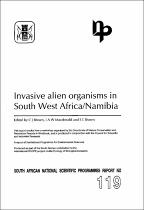JavaScript is disabled for your browser. Some features of this site may not work without it.
- ResearchSpace
- →
- Archives collection
- →
- Open Access Reports
- →
- View Item
| dc.contributor.author |
Brown, CJ

|
|
| dc.contributor.author |
Macdonald, IAW

|
|
| dc.contributor.author |
Brown, SE

|
|
| dc.date.accessioned | 2008-08-25T13:06:02Z | |
| dc.date.available | 2008-08-25T13:06:02Z | |
| dc.date.issued | 1985 | |
| dc.identifier.citation | Brown, CJ, Macdonald, IAW and Brown, SE (Editors). 1985. Invasive alien organisms in South West Africa/Namibia. National Scientific Programmes Unit: CSIR, SANSP Report 119, 1985, pp 81 | en |
| dc.identifier.isbn | 0-7988-3800-0 | |
| dc.identifier.uri | http://hdl.handle.net/10204/2427 | |
| dc.description.abstract | The greatest threat of invasion of alien species of plants and animals is posed by species which originate from similar arid habitats in other parts of the world. In general the smaller the number of individuals of an alien species introduced into the country, the smaller are its chances of becoming established as an invasive problem species. For this reason all efforts at reducing the numbers of alien species should be regarded as worthwhile, even if total eradication of the species seems impossible. Approximately 40 species of invasive alien plants have been identified in SWA/Namibia. The species of greatest concern in order or priority are Salvinia molesta, Prosopis spp, Nicotian glauca, Datura spp and Opuntia spp, although priorities differ from place to place. The areas most prone to invasion are the river washes, particularly those rising on or running through farmlands. Seed dispersal in these areas is mainly waterborne. Other invasion-prone ecosystems are those associated with perennial river systems (eg the Kavango and Caprivi areas). Although reasonably isolated in the past, these regions are developing fast, with the resultant dangers of invasion by many species which tend to spread with the spread of human habitation. The perennial availability of water allows many more species of alien plants to become established in these areas than in other parts of the country | en |
| dc.language.iso | en | en |
| dc.publisher | Foundation for Research Development: CSIR | en |
| dc.relation.ispartofseries | CSIR | en |
| dc.subject | SANSP | en |
| dc.subject | Birds | en |
| dc.subject | Namibia | en |
| dc.subject | Plants | en |
| dc.subject | Deserts | en |
| dc.subject | Alien species | en |
| dc.subject | Animals | en |
| dc.title | Invasive alien organisms in South West Africa/Namibia | en |
| dc.type | Report | en |
| dc.identifier.apacitation | Brown, C., Macdonald, I., & Brown, S. (1985). <i>Invasive alien organisms in South West Africa/Namibia</i> (CSIR). Foundation for Research Development: CSIR. Retrieved from http://hdl.handle.net/10204/2427 | en_ZA |
| dc.identifier.chicagocitation | Brown, CJ, IAW Macdonald, and SE Brown <i>Invasive alien organisms in South West Africa/Namibia.</i> CSIR. Foundation for Research Development: CSIR, 1985. http://hdl.handle.net/10204/2427 | en_ZA |
| dc.identifier.vancouvercitation | Brown C, Macdonald I, Brown S. Invasive alien organisms in South West Africa/Namibia. 1985 [cited yyyy month dd]. Available from: http://hdl.handle.net/10204/2427 | en_ZA |
| dc.identifier.ris | TY - Report AU - Brown, CJ AU - Macdonald, IAW AU - Brown, SE AB - The greatest threat of invasion of alien species of plants and animals is posed by species which originate from similar arid habitats in other parts of the world. In general the smaller the number of individuals of an alien species introduced into the country, the smaller are its chances of becoming established as an invasive problem species. For this reason all efforts at reducing the numbers of alien species should be regarded as worthwhile, even if total eradication of the species seems impossible. Approximately 40 species of invasive alien plants have been identified in SWA/Namibia. The species of greatest concern in order or priority are Salvinia molesta, Prosopis spp, Nicotian glauca, Datura spp and Opuntia spp, although priorities differ from place to place. The areas most prone to invasion are the river washes, particularly those rising on or running through farmlands. Seed dispersal in these areas is mainly waterborne. Other invasion-prone ecosystems are those associated with perennial river systems (eg the Kavango and Caprivi areas). Although reasonably isolated in the past, these regions are developing fast, with the resultant dangers of invasion by many species which tend to spread with the spread of human habitation. The perennial availability of water allows many more species of alien plants to become established in these areas than in other parts of the country DA - 1985 DB - ResearchSpace DP - CSIR KW - SANSP KW - Birds KW - Namibia KW - Plants KW - Deserts KW - Alien species KW - Animals LK - https://researchspace.csir.co.za PY - 1985 SM - 0-7988-3800-0 T1 - Invasive alien organisms in South West Africa/Namibia TI - Invasive alien organisms in South West Africa/Namibia UR - http://hdl.handle.net/10204/2427 ER - | en_ZA |






